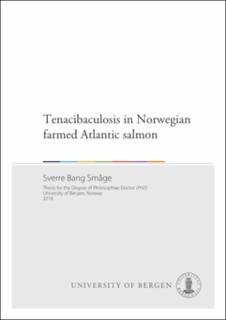| dc.contributor.author | Småge, Sverre Bang | |
| dc.date.accessioned | 2019-05-02T07:46:24Z | |
| dc.date.available | 2019-05-02T07:46:24Z | |
| dc.date.issued | 2018-12-06 | |
| dc.identifier.uri | http://hdl.handle.net/1956/19440 | |
| dc.description.abstract | Tenacibaculosis is a bacterial ulcerative skin disease of many economically important farmed fish species worldwide caused by members of genus Tenacibaculum. For the Norwegian salmon farming industry, however, tenacibaculosis was not recognized as an important disease until 2010. Since then, the increased use of media supporting Tenacibaculum growth has resulted in the identification of Tenacibaculum spp. from a large number of outbreaks of skin lesions/ulcers. Bacterial skin infections that cause skin lesions/ulcers in farmed Atlantic salmon are not only important fish health and welfare issues that needs to be solved, but also cause significant economic losses. From investigations of tenacibaculosis outbreaks in the northernmost parts of Norway, a Tenacibaculum sp. strain was repeatedly identified over several years at multiple farms. Sequence similarity analysis showed that this Tenacibaculum sp. strain was most closely related to Tenacibaculum dicentrarchi, but different enough to constitute a novel Tenacibaculum species. A polyphasic investigation showed that this was indeed a novel species in the genus Tenacibaculum, for which the name Tenacibaculum finnmarkense was proposed. The delineation of T. finnmarkense and T. dicentrarchi has since been further demonstrated by whole genome analysis. In September 2015, two separate outbreaks of tenacibaculosis occurred at two Atlantic salmon farms in Northern Norway. The events resulted in major losses of smolts newly transferred into seawater. Prior to, and during the outbreaks, large numbers of small jellyfish, identified as Dipleurosoma typicum (Boeck) were observed in the vicinity of the farms and inside the net-pens. During these outbreaks, T. finnmarkense was found to be the dominant bacteria associated with the outbreaks. Moreover it was shown that D. typicum were unlikely to be a vector for T. finnmarkense. However, it was shown that the jellyfish caused direct damage to the fish’s skin which likely exacerbated the bacterial infection by allowing an entry point for T. finnmarkense. Bath challenges conducted during this study using T. finnmarkense and Atlantic salmon smolts showed that for the first time this bacterium was able to induce tenacibaculosis as it presents in the field without pre-stressors or co-infection. The study also showed that there is pathogenic variation between T. finnmarkense strains, with T. finnmarkense strain HFJT being the most pathogenic. A cohabitation experiment showed that T. finnmarkense does not appear to spread horizontally from fish to fish and more work is therefore required to determine possible reservoirs and/or vectors for this bacterium. Due to the success of vaccines targeting other bacterial pathogens in Norwegian farmed Atlantic salmon, the efficacy of a whole cell inactivated vaccine targeting T. finnmarkense was tested. Despite the vaccines inducing an antibody response, they did not manage to give any protection against tenacibaculosis induced through a bath infection. Future research needs to focus on mitigation tools, which will need to include refining the challenge model necessary for testing such tools. | en_US |
| dc.language.iso | eng | eng |
| dc.publisher | The University of Bergen | en_US |
| dc.relation.haspart | Paper I: Småge, S.B., Brevik, Ø.J., Duesund, H., Ottem, K.F., Watanabe, K., Nylund, A. (2015) Tenacibaculum finnmarkense sp. nov., a fish pathogenic bacterium of the family Flavobacteriaceae isolated from Atlantic salmon. Antonie van Leeuwenhoek, 109, 273-285. The article is available at: <a href="http://hdl.handle.net/1956/15237" target="blank">http://hdl.handle.net/1956/15237</a> | en_US |
| dc.relation.haspart | Paper II: Småge, S.B., Brevik, Ø.J., Frisch, K., Duesund, H., Watanabe, K., Nylund, A. (2017) Concurrent jellyfish blooms and tenacibaculosis outbreaks in Northern Norwegian Atlantic salmon (Salmo salar) farms. PLOS ONE. 12(11): e0187476. The article is available at: <a href="http://hdl.handle.net/1956/18141" target="blank">http://hdl.handle.net/1956/18141</a> | en_US |
| dc.relation.haspart | Paper III: Småge, S.B., Frisch, K., Vold, V., Duesund, H., Brevik, Ø.J. Hetlelid Olsen, R., Sjaatil, S.T., Klevan, A., Brudeseth, B., Watanabe, K., Nylund, A. (2018) Experimentally induced tenacibaculosis in Atlantic salmon smolts using Tenacibaculum finnmarkense. Aquaculture, 495, 858 -864. The article is available at: <a href="http://hdl.handle.net/1956/19439" target="blank">http://hdl.handle.net/1956/19439</a> | en_US |
| dc.title | Tenacibaculosis in Norwegian farmed Atlantic salmon | en_US |
| dc.type | Doctoral thesis | |
| dc.rights.holder | Copyright the author. All rights reserved | en_US |
| dc.identifier.cristin | 1645659 | |
